Updated: August 13, 2024
By Santorini Dave • dave@santorinidave.com
Our Favorite Hotels in Milan
• 5-star: Four Seasons
• 4-star: Room Mate Giulia
• 3-star: Brera Prestige
• Boutique: Bulgari
• For couples: Palazzo Parigi
• For families: Brera Apartments
• Near train station: Excelsior Gallia
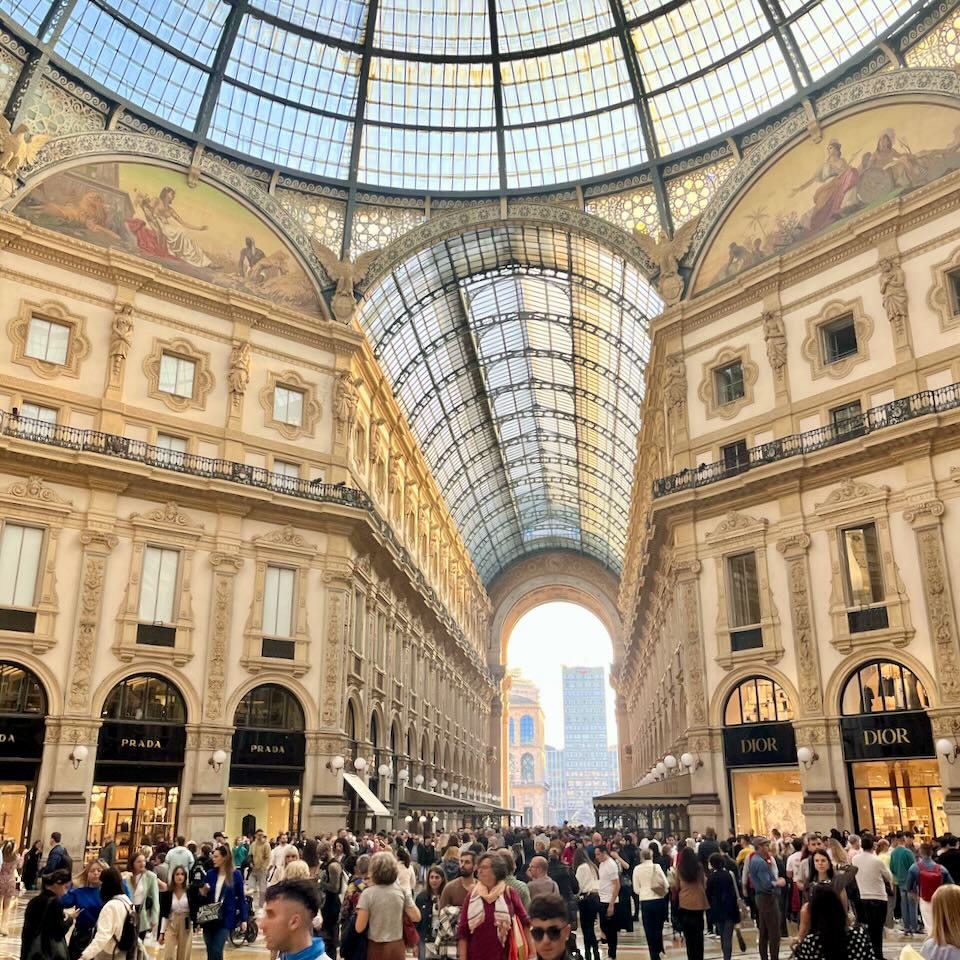
We think that staying near the Galleria Vittorio Emanuele II shopping arcade – the heart of Milan – is ideal for first-time visitors. Room Mate Giulia, the Park Hyatt, and Sina De La Ville are wonderful hotels in the area.
The Best Areas to Stay in Milan
Milan, Italy’s second-largest city, boasts a vibrant blend of history and modernity that captures the essence of Italian culture – without the crowds of tourists found in Venice, Florence, and Rome.
Renowned as a fashion capital and university hub, Milan is also home to some of Italy’s most iconic landmarks, such as the awe-inspiring Duomo, Da Vinci’s Last Supper, and the majestic Scala opera house. However, Milan is much more than a mere tourist destination. It’s a city where you can discover cutting-edge art galleries, such as the Fondazione Prada, and marvel at greenery-covered skyscrapers. You can also sip coffee in a Wes Anderson-designed café or explore the city’s hip bars and chic boutiques.
The Duomo di Milano
Neighborhoods in Milan
Milan emanates outward in concentric circles from the famous Piazza Duomo, a bustling square that serves as the city’s geographic and cultural center. Most tourist activity and the bulk of the city’s museums and art centers are found nearby; to the north, you’ll find the fine art of the Pinacoteca di Brera and, nearby, the “Quadrilatero d’Oro”, a concentration of top designer fashion boutiques. For those willing to stray a little further, the area near Park Sempione and the Arco della Pace (Peace Arch) to the west offers a great atmosphere for aperitivo, Milan’s version of happy hour, and the impressive Castello Sforzesco.
For those seeking the city’s vibrant nightlife, the Navigli district to the southwest is a premier destination, characterized by its two canals and energetic atmosphere. West of the cathedral, the Zona Magenta’s Museo Archeologico gives a taste of Roman Milan, while the church of Santa Maria delle Grazie is home to Leonardo da Vinci’s Last Supper. Milan’s attractions extend beyond the historic city center, with the glistening skyscrapers and haute cuisine of Porta Nuova/Porta Garibaldi in the north and the parks and conservatories of Porta Venezia to the east. Whether you’re seeking history, culture, fashion, or nightlife, Milan’s concentric circles of neighborhoods offer a wide range of hotels and plenty of sights for everyone.
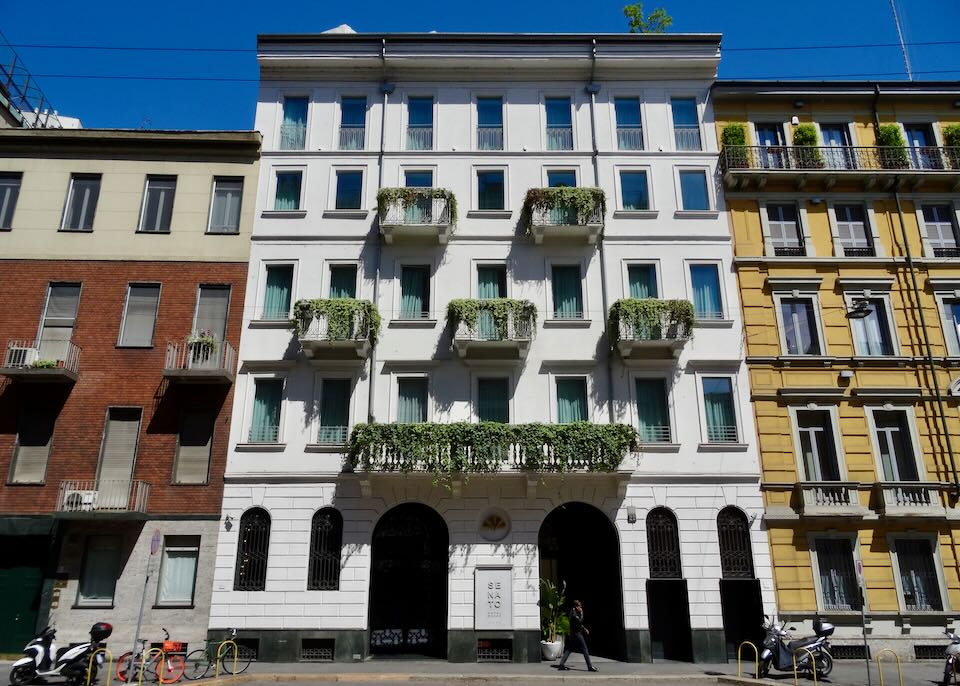
Senato is one of many wonderful luxury options we like near the Quadrilatero d’Oro shopping hub, and just a few minutes walk to the Duomo.
Transportation in Milan
Getting around is relatively easy, as Milan is mostly flat and of manageable size. The historic city center, known as the Centro Storico, can be walked from one end to the other in under an hour.
Visiting Milan without a car is made easy by its extensive network of trams, buses, and underground metro system. The Stazione Centrale (Central) and Duomo intersections serve as the main transit hubs, connecting the city’s various neighborhoods. A single ride on Milan’s public transport system costs €2, but a 24-hour ticket (€7) is recommended for travelers planning to use any form of transport more than three times. While taxis are available, they are not the most practical way to get around Milan, and walking or using public transit is often the preferred method of transportation.
Hotels near Milan metro: Excelsior Gallia (Central Station) • Hotel Zara (Zara Station) • Urban Hive Milano (Moscova Station) • Hotel Fenice (Porta Venezia Station) • Amabilia Suites (Duomo Station) • Hotel Tocq (Garibaldi Station) • Portrait Milano (San Babila Station)The Best Places to Stay in Milan
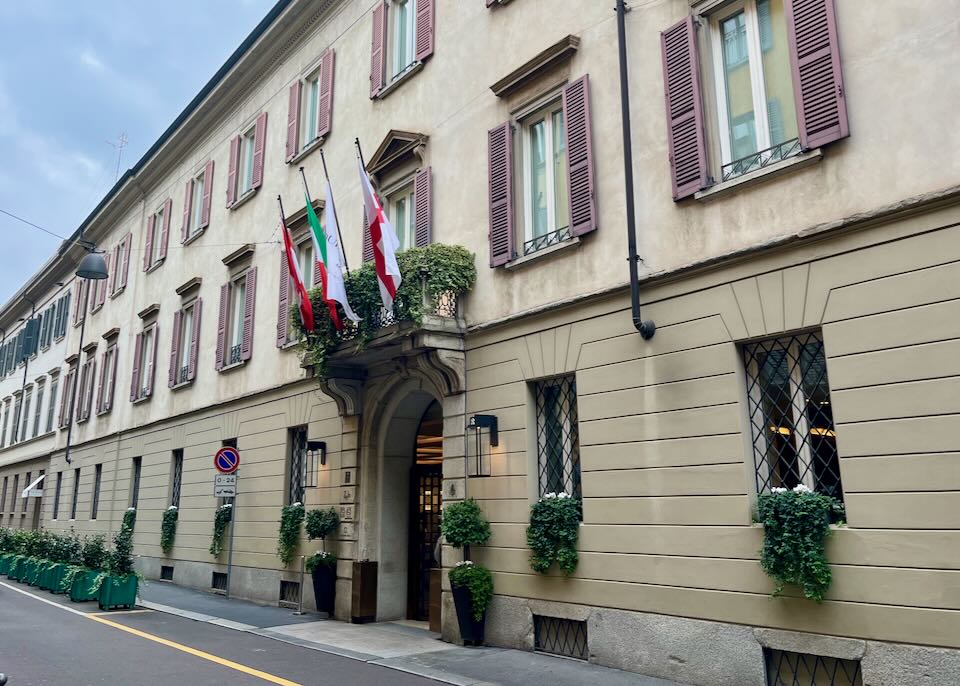
In a city with no shortage of of excellent luxury hotels, the Four Seasons Milan is our favorite.
- Best Luxury Hotels in Milan
Grand Hotel et de Milan • Four Seasons • Mandarin Oriental • Palazzo Parigi • Portrait Milano • Armani- Best Boutique Hotels in Milan
Château Monfort • Bulgari • Aethos • Room Mate Giulia • Senato • The Street Milano Duomo- Best Cheap/Midrange Hotels in Milan
B&B Sant’Ambrogio • Biocity • Brera Prestige • Hotel Cavour • Moscova Luxury B&B- Best Hostels in Milan
Babila • Ostello Bello Duomo • Ostello Bello Centrale • YellowSquareBest Places in Milan for…
- Best Neighborhood for Sightseeing: Brera
Immediately northwest of the city center is a tangle of narrow streets known as the Brera. It’s a trendy area, with relatively sparse car traffic and a mix of locals and tourists enjoying shops, restaurants, bars, and the Pinacoteca de Brera – arguably the city’s most important art museum. The Brera is close to Milan’s most impressive attractions as well: Castello Sforzesco, Park Sempione, and the Duomo/Galleria area all a short walk away. A little further west is Santa Maria delle Grazie, home of Da Vinci’s famous Last Supper fresco.
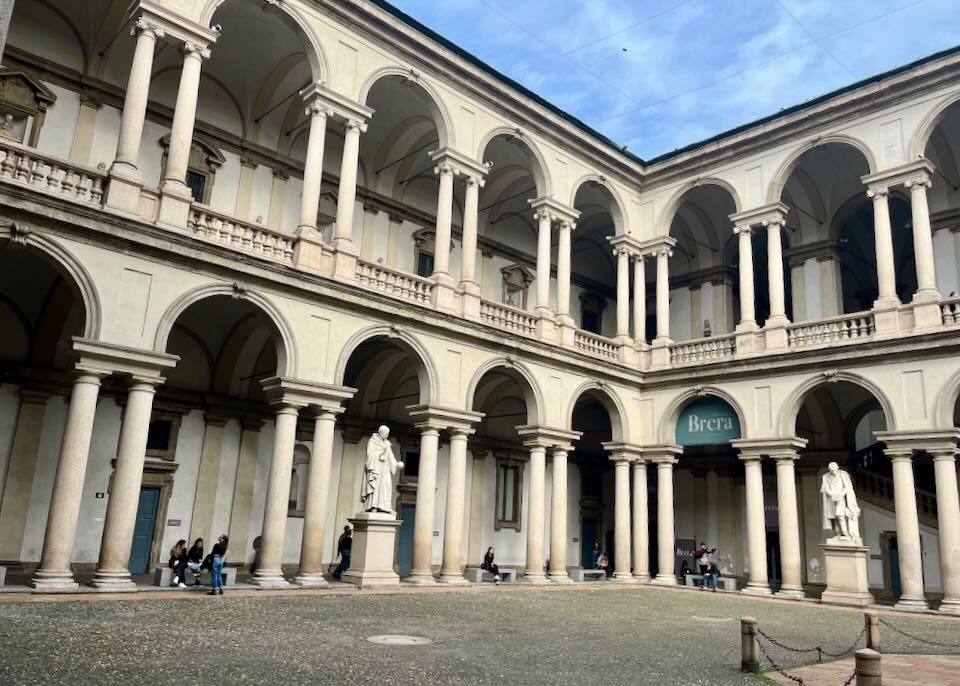
Pinoteca di Brera
- Most Romantic Neighborhood: San Lorenzo
Just south and west of the Duomo lies the small, quiet enclave around the ancient columns of Piazza San Lorenzo and the nearby Basilica. It’s a common meeting place for locals gathering with friends or as a starting place for dates out on the town. There are several small hotels and hostels nearby and along Corso di Porta Ticinese – lined with impressive street art, a variety of local shops, and charming restaurants offering top-notch Milanese cuisine.- Best Neighborhoods for Nightlife: Navigli and Isola
On the south edge of town, a pair of canals that once transported material to build the city’s Duomo in the city center are now home to Milan’s most vibrant party scene. Lined with dozens of bars, restaurants, and shops, the Navigli district was upgraded after the 2015 Expo and connected to the rest of the city via the revamped Porta Ticinese. Locals now pile in every night to enjoy aperitivo, Italy’s version of happy hour. Many bars offer entire buffets of free food (though you have to buy a drink), vying with each other to entice the biggest crowds. Of the two canals, Naviglio Grande is the epicenter, although Naviglio Pavese, the smaller canal to the south, gets its fair share of foot traffic as well. Be sure to explore the side alleys and avenues off the canals themselves; you’ll find many excellent drinking and dining options hiding in the shadows. Highlights include the craft cocktails at Rita (home to the “Cazzi Tuoi”cocktail), Pinch Spirits & Kitchen, the Blues Canal pub, and boho chic Zog.Those interested in live music and clubs should head to Isola further north; here you’ll find a variety of electronic music options, as well as the Milan outpost of the New York-based Blue Note jazz nightclub. Other cocktail bars worth checking out include Bob Milano, Bar BAH, Cru Isola (for wine), and Bar Frida.
- Best Neighborhood for Food and Restaurants: Porta Nuova/Porta Garibaldi
While great food abounds in Milan, serious foodies should head north to Porta Nuova/Porta Garibaldi. There you will find the Eataly complex, a 4-story emporium devoted to Italian cuisine, as well as numerous exciting restaurants off Corso Garibaldi, with a mix of traditional Milanese fare (including the renowned osso bucco) and newcomers featuring farm-to-table menus and impressive seafood-based creations from Sicilian chefs. Top picks include northern Italian Ratanà, Michelin-starred Ristorante Berton, and high-end Japanese restaurant Yoshinobu. Just to the west, Milan’s Chinatown is packed with East Asian restaurants and stalls (like dumpling specialist Ravioleria Sarpi), as well as traditional osterias and old-school wine shop Cantine Isola.For those with bigger wallets, the Quadrilatero d’Oro area and its Michelin-starred hotel restaurants offer a wealth of options, including world-class sushi at the Armani Hotel’s famed Nobu, and high-end, contemporary Italian at Seta, inside the Mandarin Oriental.
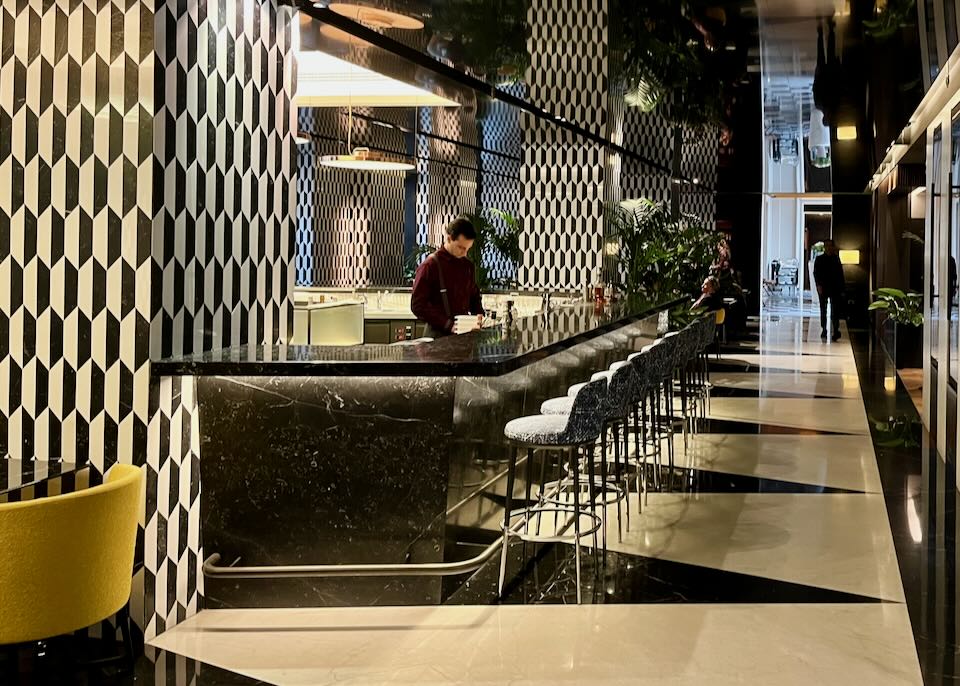
The fantastic and charming Mandarin Oriental Hotel in central Milan.
- Best Neighborhoods for Local Vibe: Porta Venezia and Porta Romana
Porta Venezia is a famous hangout spot for the artistic community and one of Milan’s best places to stay to feel like a local. Despite its proximity to the Duomo, Porta Venezia is not too crowded, since most tourists often bypass this neighborhood. You will find several art galleries and museums here, including the Galleria d’Arte Moderna and Padiglione D’Arte Contemporanea. It’s home to several gay bars and a popular meeting place for Milan’s LGBTQ community. The area also features beautiful churches and parks, as well as some of Milan’s best gelato shops. If you are looking for affordable places to stay while being close to the top attractions in the city, Porta Venezia is a great neighborhood to consider. And since it has several parks and open spaces, this neighborhood is also an excellent choice for families.Similarly, Porta Romana just to the south is a primarily residential area best known for its nightlife spots and redeveloped industrial areas (one of which is set to become the Olympic Village for the 2026 Winter Games). Highlights here include the Rem Koolhaas-designed Fondazione Prada arts complex, with stylish Bar Luce, designed by American film-maker Wes Anderson, but there are also some of the city’s best clubs and snack stalls, including the roast chicken sold at Giannasi dal 1967, on Piazza Bruno Buozzi.
The Wes Anderson-designed Bar Luce inside the Fondacione Prada in Porta Romana.
- Best Neighborhood for First Time Visitors: Centro Storico
Milan has many impressive sights, but nothing beats the Piazza del Duomo, with its huge gothic-inspired cathedral and the looming, baroque Galleria complex that houses the flagship stores for Prada and Bulgari, along with dozens of shops, restaurants, and bars. (The iconic Camparini bar has been serving Campari-based cocktails for over 100 years.) After exploring the Duomo and taking a stroll through the Galleria, a short walk to the north – past rows of 18th century facades and the historic opera house Teatro alla Scala – takes you to Via Della Spiga; a narrow, pedestrian-only avenue, full of beautiful and stylish hotels, and world-class window shopping. Staying in the Centro Storico you’ll also be within walking distance of all the other major sights: the shops of Brera and Quadrilatero d’Oro; Castello Sforzesco and Parco Sempione; and Da Vinci’s Last Supper at the Santa Maria delle Grazie.- Best Neighborhoods for Shopping: Quadrilatero d’Oro and San Lorenzo/Tortona
Though there’s plenty of shopping in the Centro Storico – in Galleria Vittorio Emanuele II and along Via Torino especially – head to the Quadrilatero d’Oro for spectacular window shopping amongst lavish boutiques and high-end fashion houses. All four streets of the “Quad” are worth exploring – Montenapoleone, Manzoni, Corso Venezia, and especially Via della Spiga. Corso Buenos Aires is the northern continuation of Corso Venezia and is also lined with shops, with designers sharing space with high-street brands such as Levi’s and Mango. For a more independent scene, with cult fashion stores and niche footwear, stroll south along Corso di Porta Ticinese towards Navigli, where you’ll find vintage clothes at Lo Specchio Di Alice, handmade shoes at Panca’s, jewelry at Laboratorio Tam Tam, and vinyl at Serendeepity. Head west to Tortona for smattering of newer designer boutiques such as the Boglioli Showroom and Lanificio Luigi Colombo.- Safest Areas in Milan
Milan has come a long way over the last several years, and while some parts of town used to be somewhat risky in terms of pickpockets and property theft, you are now more or less OK anywhere in the city center. The areas east and southeast of the Duomo are the least touristy, with fewer scam artists looking to prey on out-of-towners. Risks are lower too in the north part of the city, all the way up from the shopping district and fancy hotels around Via Della Spiga into Porta Nuova and the Isola district. Navigli, the main nightlife district, should also be fine.- Unsafe Areas in Milan
Nowhere in central Milan is truly unsafe, but watch yourself at Central Station, where groups of drunks, drug dealers, and homeless people often congregate. It’s been cleaned up quite a bit over the last decade, but you still might meet scam artists looking to offer you “help” while buying train tickets, and unregulated “taxi drivers” who will fleece you on your ride to the hotel. It’s smart to keep an eye out while at the other train stations, as well, including those located at Garibaldi near Isola, and at Cadorna, near Sforza Castle. Other areas in which to be on your guard include neighborhoods outside the city center, particularly the area around San Siro where Milan’s main soccer field is located.
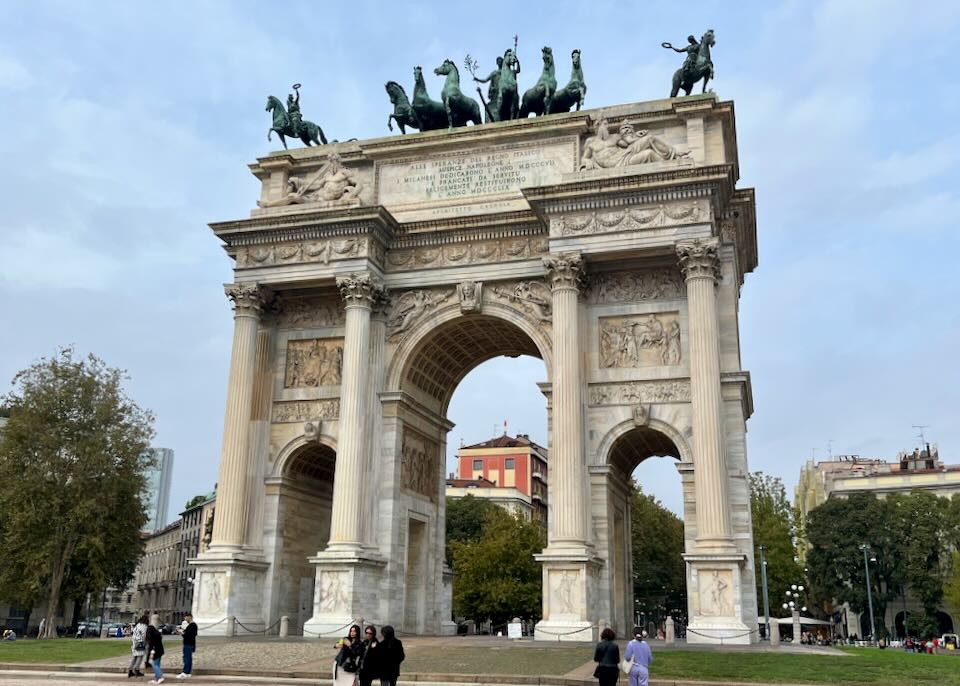
Arco della Pace (Peace Arch) at the entrance to Parco Sempione.
The 9 Best Neighborhoods in Milan for Tourists
1. Centro Storico and San Babila
Art museums, world-class shopping experiences, cultural landmarks, bars, and restaurants, all topped by one massive cathedral: for those stopping in Milan for a short while, this is the one part of town that can’t be missed. Any Milanese experience should start at the Piazza del Duomo, a breathtaking square with its huge gothic-inspired cathedral, the glittering Galleria Vittorio Emanuele II shopping arcade, Palazzo Reale di Milano (the old royal palace), modern art in the Museo del Novecento, and the medieval Palazzo della Ragione. Be sure to try a Campari at the Camparino in Galleria cocktail bar overlooking the square.
From the Duomo, stroll through the Galleria, past the Leonardo3 Museum, to the Piazza della Scala to see the world’s greatest opera house up close (you can learn more about it at the Teatro alla Scala Museum), or peruse the 19th- and 20th-century art inside the Gallerie d’Italia. There’s even more lavish art displayed inside the nearby Museo Poldi Pezzoli, while the Casa del Manzoni celebrates Italy’s most famous 19th-centurywriter. Stroll east up the Corso Vittorio Emanuele II to San Babila, a quiet enclave of piazzas and well-to-do Milanese to get away from the tourist hubbub. End the day at the Ginrosa bar on Piazza San Babila, home of the Ginrosa aperitif.
There’s a surprisingly limited choice of hotels here, and given the convenient location, it tends to be very expensive. Expect the area around Piazza del Duomo and Galleria Vittorio Emanuele II to be extremely busy, at least during the day.
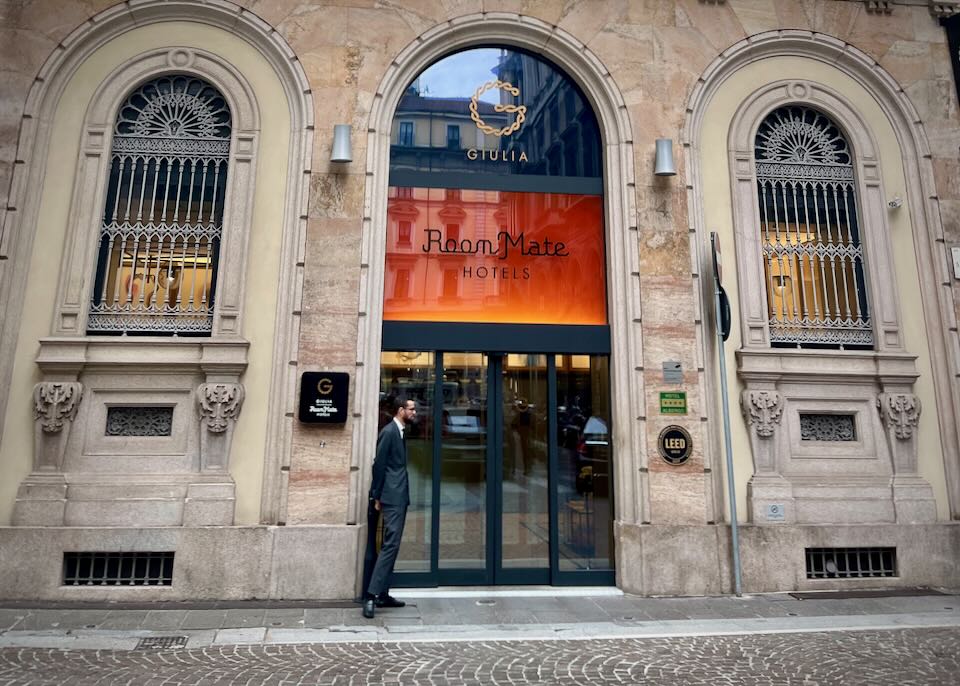
Room Mate Giulia in Centro Storico
- Best Hotels in Centro Storico & San Babila
Spadari Al Duomo • Hotel phone: +39 02 7200 2371
Park Hyatt Milan • Hotel phone: +39 02 8821 1234
Palazzo Segreti • Hotel phone: +39 02 4952 9250
Palazzo Touring Club • Hotel phone: +39 02 1241 28300
Room Mate Giulia • Hotel phone: +39 02 8088 8900
The Street Milano Duomo • Hotel phone: +39 02 3676 5691- Best Cheap/Midrange Hotels
B&B Hotel Milano Duomo • Hotel phone: +39 02 8901 0685
BC Maison • Hotel phone: +39 334 946 5964
Brunelleschi Hotel • Hotel phone: +39 02 88431- Best Hostels
Babila Hostel • Hotel phone: +39 02 3658 8491
Ostello Bello Duomo • Hotel phone: +39 02 3658 27202. Brera and Parco Sempione
Immediately northwest of the city center is a tangle of narrow streets known as the Brera. Formerly the city’s artist quarter, today it’s an affluent, festive area, with relatively sparse traffic and a mix of locals and tourists enjoying the posh shops, restaurants, and bars. The district’s central street, Via Brera, is dedicated to high-end fashion and perfume stores, but the neighborhood’s crowning glory is the Pinacoteca di Brera – arguably the city’s most important art museum. Brera is wedged between the Quad (for more luxury shopping), and the wonderful Parco Sempione to the west, whose many attractions could easily take up a day or more. The unmissable Castello Sforzesco provides a picturesque gateway to the park. Built by the Sforza family, who – along with their predecessors, the Viscontis – ruled Milan like royals for centuries, the castle today houses some of the city’s most absorbing museums (fantastic for kids), but you can stroll around the main courtyards for free. The top end of the park is framed by the imposing Arco della Pace, leading to a glorious boulevard lined with bars and restaurants (Corso Sempione, perfect for aperitivo). Also in the park stands the Torre Branca viewing tower and the Triennale di Milano museum, which showcases the city’s fabulous design legacy.
If you want to be close to Milan city center but without the hustle and bustle, Brera is a great area to stay. It’s the primary base for the city’s major luxury chains and hip boutique hotels, and rates tends to be correspondingly high.
- Best Hotels in Brera & Parco Sempione
Bulgari Hotel • Hotel phone: +39 02 805 8051
Grand Hotel et de Milan • Hotel phone: +39 02 723141
Mandarin Oriental • Hotel phone: +39 02 8731 8888
Palazzo Parigi • Hotel phone: +39 02 625625- Best Midrange Hotels
Brera Prestige B&B • Hotel phone: +39 393 857 8228
UNAHOTELS Cusani Milano • Hotel phone: +39 02 85601
The Unique • Hotel phone: +39 02 2416 51853. Quadrilatero d’Oro
World class shopping and elegant streets: this part of Milan encapsulates what makes this city stand shoulder-to-shoulder with London, New York, and Paris. The ‘Golden Quad’, aka Quadrilatero della Moda, refers to the four streets – Via Montenapoleone, Via Manzoni, Corso Venezia, and Via della Spiga – that anchor Milan’s premier luxury shopping district just northeast of the Centro Storico. The neighborhood is filled with the biggest names in fashion and accessories (not to mention the uber-luxe food and accommodation options to complement the experience). Sights here include the Museo Bagatti Valsecchi, a beautifully preserved 16th-century townhouse, and the Palazzo Morando, with its collection of paintings, sculptures, costume, and fashions from the past.
Like the adjacent Brera neighborhood, accommadation rates here are very expensive, with luxury hotels predominating – it’s an easy walk or metro ride from the rest of the city.
- Best Hotels near Quadrilatero d’Oro
Armani Hotel • Hotel phone: +39 02 8883 8888
Four Seasons • Hotel phone: +39 02 77088
Hotel Manzoni • Hotel phone: +39 02 7600 5700
Mandarin Oriental • Hotel phone: +39 02 8731 8888
Portrait Milano • Hotel phone: +39 02 3679 95800
Senato • Hotel phone: +39 02 781236- Best Cheap/Midrange Hotel
Hotel Cavour • Hotel phone: +39 02 6200014. Zona Magenta
Just southwest of Parco Sempione (and a mile or so west of the Duomo), the Zona Magenta neighborhood contains three of Milan’s great treasures: the Civic Archeological Museum, the Science and Technology Museum, and the Santa Maria delle Grazie church, which houses one of the most famous art works in history – Da Vinci’s Last Supper. Opposite the church, a relatively new museum, La Vigna di Leonardo, preserves a beautiful old palazzo and Da Vinci’s own vineyard. Meanwhile, the Civic Archeological Museum, situated near a small section of the medieval city wall and featuring a Roman dwelling from the 1st century, offers a fabulous insight into the city’s ancient past. The interior of the adjacent church of San Maurizio al Monastero Maggiore is blanketed with wonderful frescoes; it’s just one of several stunning churches in the neighborhood, including the Basilica di Sant’Ambrogio and Basilica di San Vittore al Corpo.
Zona Magenta offers surprisingly few places to stay – beyond the main sights it’s much quieter and residential than the Centro Storico.
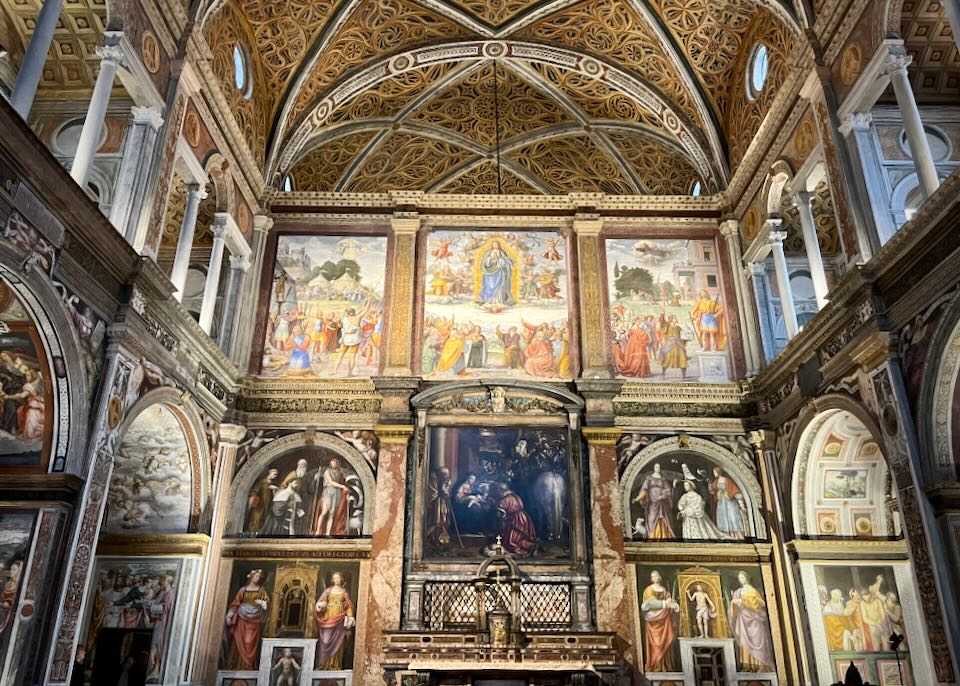
The incredible frescoes of San Maurizio al Monastero Maggiore
- Best Hotel near Zona Magenta
Antica Locanda Leonardo • Hotel phone: +39 02 4801 4197- Best Cheap/Midrange Hotels
B&B Sant’Ambrogio • Hotel phone: +39 02 4810 10895. Navigli and Tortona
A 10-minute stroll southwest from the Duomo brings you to San Lorenzo, a small artsy neighborhood anchored by the striking Basilica San Lorenzo Maggiore and nearby Roman columns, a common meeting place for locals before strolling down Corso di Porta Ticinese. Lined with street art, independent boutiques, and gelaterias, this street ends at another grand church, the Basilica di Sant’Eustorgio, and the ancient Porta Ticinese gate on Piazza Ventiquattro Maggio, a major intersection. This is the gateway to the fashionable Navigli district to the south.
This hip enclave is situated along and around the banks of the Naviglio Grande and Naviglio Pavese, two freshwater canals that flow into the Darsena basin at Porta Ticinese. No visit to Milan is complete without spending a bit of time in Navigli. Not only can you spend hours wandering the towpaths and finding cute boutiques and flower-filled courtyards filled with artist studios, but at night, it becomes the beating heart of Milan’s nightlife as the restaurants and bars fill up and spill out onto the streets. (It’s also popular with students at the nearby IULM and SFU universities). On the north side of Naviglio Grande, Porta Genova gives way to up-and-coming Zona Tortona, a former industrial district where you’ll find one of Milan’s best museums, David Chipperfield’s Museo delle Culture (Mudec), which draws big name exhibitions and houses a Michelin-starred restaurant. The area is also home to the futuristic Armani/Silos, which hosts traveling art exhibitions as well as an extensive permanent collection of Armani fashion. Nearby BASE Milano serves as the cultural hub for the district, an event venue with café and bar. This area is home to the annual Milan Design Week, and the “Mercatone dell’Antiquariato” antique and flea market lines the Naviglio Grande on the last Sunday of each month.
Navigli is the best area of Milan to stay for nightlife. It’s also a lot cheaper, as it’s a little far from the central sights. The walk into town is enjoyable but expect to rely on trams, buses, and taxis a lot more if staying down here.
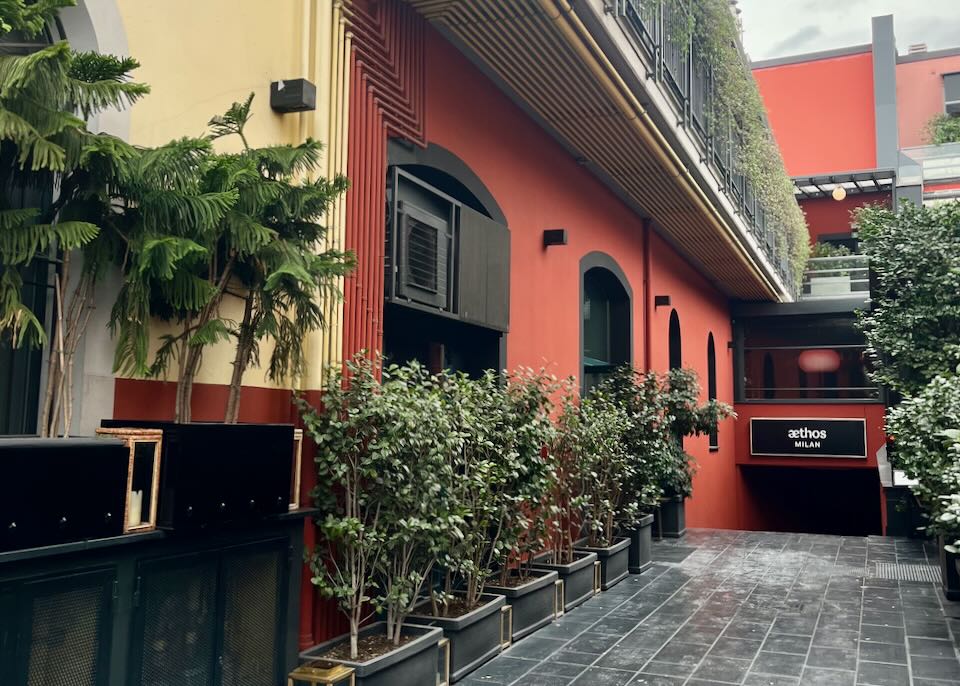
Aethos Milan is a fantastic boutique hotel located next to the Naviglio Grande Canal.
- Best Hotels in Navigli & Tortona
Aethos Milan • Hotel phone: +39 02 8941 5901
Nhow Milan • Hotel phone: +39 02 489 8861
Magna Pars l’Hotel à Parfum • Hotel phone: +39 02 833 8371
Savona 18 Suites • Hotel phone: +39 02 255 5201
Vico Milano • Hotel phone: +39 02 4941 8437- Best Cheap/Midrange Hotels
Art Hotel Navigli • Hotel phone: +39 02 89438
Combo Milano • Hotel phone: +39 02 3668 0930
Maison Borella • Hotel phone: +39 02 5810 91146. Porta Nuova/Porta Garibaldi (including Chinatown & Isola)
The previously sketchy Porta Nuova and Porta Garibaldi areas were transformed for the 2015 World Expo, and are now studded with parks and futuristic skyscrapers, and anchored by modern Piazza Gae Aulenti. Behind the two jungle-clad Bosco Verticale skyscrapers and the Biblioteca degli Alberi park lies the rapidly gentrifying Isola neighborhood, where you’ll find a lively market (Mercato dell’Isola), the Italian outpost of New York’s famous Blue Note jazz cafe, and all the trendiest bar and restaurant openings.
South from Piazza Gae Aulenti, pedestrianized Corso Como and Corso Garibaldi are lined with great places to eat (including Eataly Milano Smeraldo, a massive emporium devoted to Italian cuisine). Just to the west, Milan’s Chinatown lies along Via Paolo Scarpi, the longest pedestrianized street in the city; it turns into a massive street market on weekends but is lined with restaurants year-round. Sights nearby include the Fabbrica del Vapore arts center, the ADI Design Museum, and the Cimitero Monumentale, the grand resting place of many local luminaries, including Arturo Toscanini and Alessandro Manzoni.
There’s a wider choice of accommodation up here, with slightly cheaper rates, though not as cheap as around the train station further north. The advantage here is that you’ll still be able to walk just about everywhere in the center, though Porta Garibaldi also is a convenient transport hub.
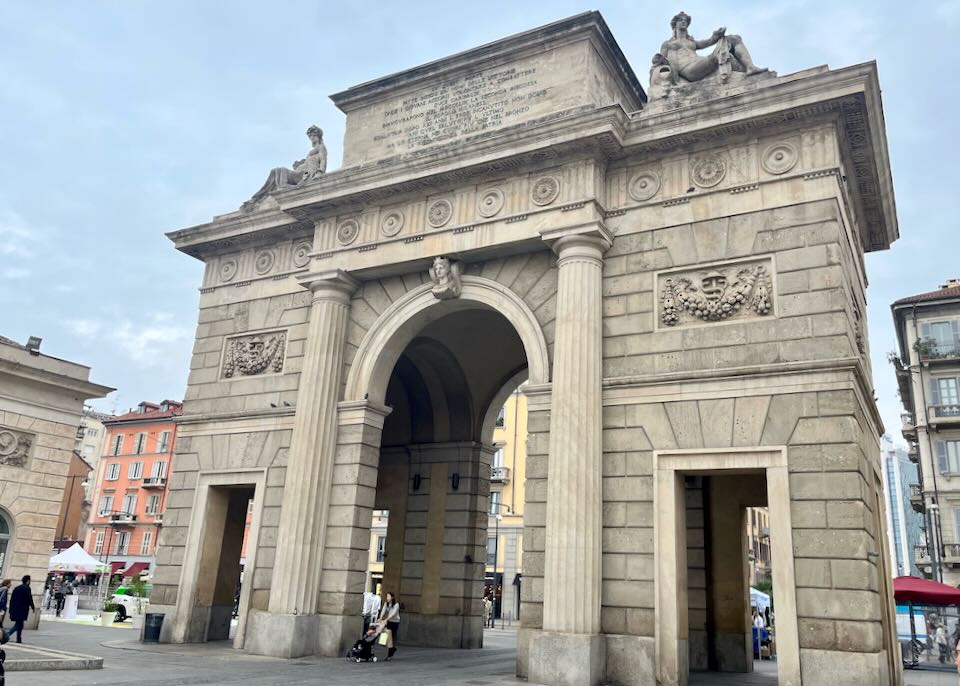
Porta Garibaldi
- Best Hotels near Porto Nuova & Porta Garibaldi
Brera Apartments • Hotel phone: +39 02 3655 6284
ME Milan Il Duca • Hotel phone: +39 02 8422 0108
Principe di Savoia • Hotel phone: +39 02 62301
Westin Palace • Hotel phone: +39 02 63361- Best Cheap/Midrange Hotels
Heart Hotel Milano • Hotel phone: +39 02 8003 0401
Moscova Luxury B&B • Hotel phone: +39 338 471 1983
NH Milano Machiavelli • Hotel phone: +39 02 631141
LaFavia Milano • Hotel phone: +39 347 78422127. Stazione Centrale & NoLo
Milan’s splendid Central Station (Stazione Centrale) building is worth strolling by even if you did not come into the city this way. Taking up nearly a whole block, the 1931 fascist-era building is still one of the largest stations in Europe and now home to the Mercato Centrale Milano, one of the city’s best food halls (Davide Longoni’s vaunted pizza by the slice is found here). On the northwest side of the station, old rail warehouses have been transformed into Dimorecentrale, a cultural hub comprising studio, office, and gallery spaces like Gluck50 and Gluqbar. Northeast of the station, NoLo (“north of Loreto”) is another once edgy and now fashionable area that remains primarily working class and multicultural, with a smattering of hotels, an eclectic dining scene (with especially good East Asian restaurants), and a small but vibrant LBGTQ nightlife (NoLoSo and GhePensi MI are favorite gay bars).
As you’d expect, there is a vast range of accommodation in the streets nearby, with some of the cheapest rates in the city, much of it good value (the quality can be hit and miss at the budget level but has improved in recent years and good deals are noted below). The area lacks in atmosphere and can be feel a bit sketchyat night (Milan’s homeless tend to congregate near the station), but there are usually plenty of people (and police) around. Given the convenient transport links, staying here isn’t a bad idea if you are aiming to save money.
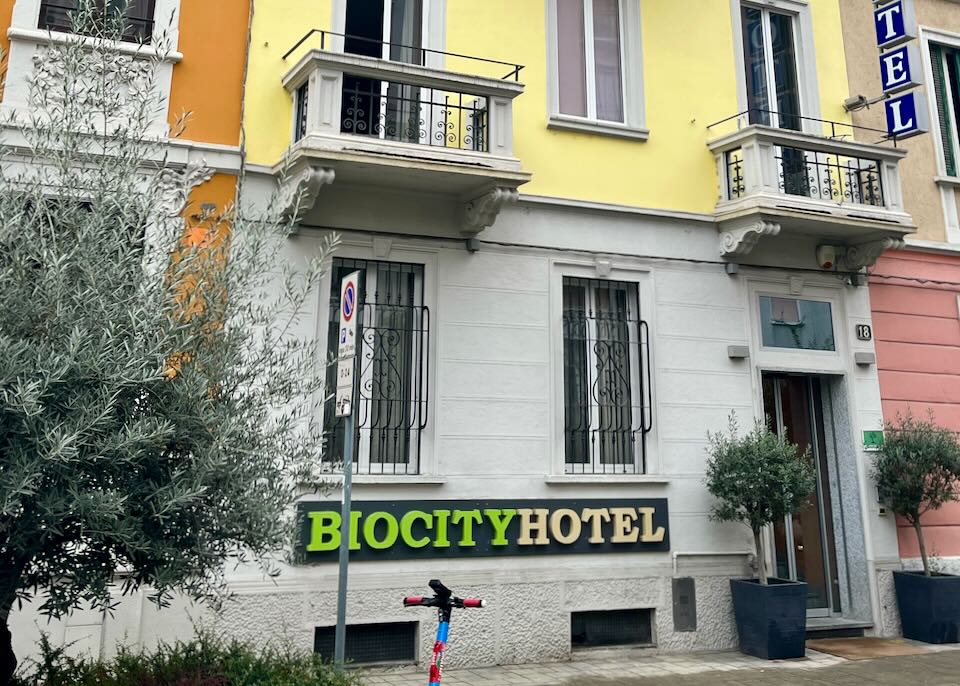
Biocity is a fantastic budget hotel just a 10-minute walk from Milan’s central train station.
- Best Hotels near Stazione Centrale & NoLo
Excelsior Hotel Gallia • Hotel phone: +39 02 67851
INNSiDE Torre GalFa • Hotel phone: +39 02 835101- Best Cheap/Midrange Hotels
43 Station Hotel • Hotel phone: +39 02 2217 9900
Biocity • Hotel phone: +39 02 6670 3595
Glam Hotel Milano • Hotel phone: +39 02 8398 4000
NYX MILAN • Hotel phone: +39 02 2217 5500- Best Hostels
Grand Hostel Coconut • Hotel phone: +39 02 3672 3255
Ostello Bello Centrale • Hotel phone: +39 02 670 59218. Porta Venezia
Just north of the Quad, the Giardini Pubblici Indro Montanelli offers a place where you can enjoy a little peace and quiet amid open green spaces, grand water fountains, and outdoor sculptures leading to the Porta Venezia neighborhood, which, as well as being the city’s main LGBTQ district (this where the Milano Pride Parade begins), offers wonderful drinking and dining options for all. The park contains Milan’s Natural History Museum, the Palazzo Dugnani, the city planetarium, and the Villa Reale, a Neoclassical palace (home to the hip LùBar restaurant), but beyond the grand Porta Venezia gateway itself there’s not a lot in the way of sights. The neighborhood is better known for shopping on the Corso Buenos Aires, East African/Eritrean cuisine (try Adulis), art galleries like Spazio Maiocchi, and nightlife – with Bar Basso (inventor of the Negroni Sbagliato) a perennial favorite. Architecture fans should seek out the Villa Necchi Campiglio, a Modernist showcase, the ivy-covered Villa Mozart, and Art Nouveau Casa Galimberti. Popular LGBTQ+-friendly bars include Leccomilano, Mono Bar, and Pop.
Hotels here are more spread out and apartment rentals are more prevalent; away from the bars, you’ll find it’s a quieter, more local neighborhood with very few tourists.
- Best Hotels near Porta Venezia
Casa Cipriani Milano • Hotel phone: +39 02 2506 4088
Château Monfort • Hotel phone: +39 02 776761
Hotel Indigo – Corso Monforte • Hotel phone: +39 02 38254
Worldhotel Cristoforo Colombo • Hotel phone: +39 02 2940 6214- Best Cheap/Midrange Hotels
L’Ottava Guesthouse • Hotel phone: +39 335 695 7302
B&B Via Fontana Milano • Hotel phone: +39 370 361 5375- Best Hostel
Babila Hostel • Hotel phone: +39 02 3658 84919. Porta Romana
The southeast edge of central Milan is encompassed within the Porta Romana area, anchored by the Arco di Porta Romana, a 16th-century city gate. It’s another primarily local residential area best known for its nightlife and redeveloped industrial areas. The Rem Koolhaas-designed Fondazione Prada is the best example of the latter, a stylish complex hosting rotating art shows and the on-site cafe, quirky Bar Luce, designed in a retro 1950s style by American filmmaker Wes Anderson. Not far away are Magazzini Generali and Plastic, two of Milan’s best-known nightclubs, as well as the famous roast chicken at no-frills stall Giannasi dal 1967, on Piazza Bruno Buozzi. The railyards opposite Fondazione Prada are being developed into the Milano Cortina Olympic Village for the 2026 Winter Games (after the Games, it will be repurposed as student housing and the Olympic Village Plaza will become a neighborhood hub).
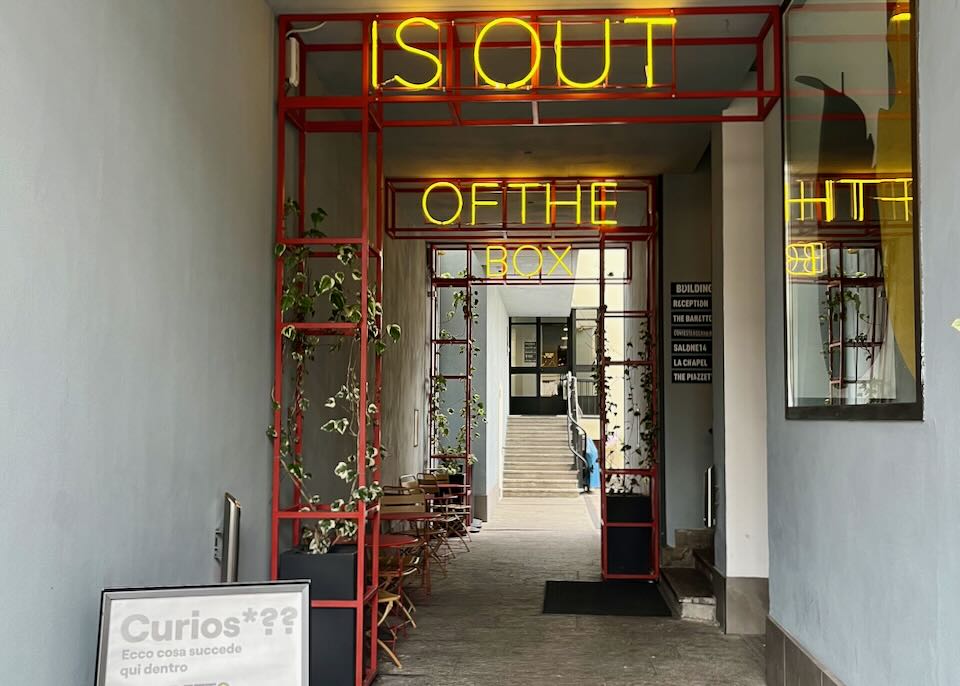
Vibrant YellowSquare in Porta Romana is one of Milan’s best hostels.
- Best Hotels near Porta Romana
Grand Visconti Palace • Hotel phone: +39 02 540341
Sigieri Residence Milano • Hotel phone: +39 02 5519 9190- Best Cheap/Midrange Hotels
Cà Bèla • Hotel phone: +39 351 531 7844
Tiaré Home Milano • Hotel phone: +39 340 965 0103
Mars Mara Bed and Breakfast • Hotel phone: +39 346 025 5753- Best Hostel
Madama Hostel • Hotel phone: +39 02 3672 7370
YellowSquare Milan • Hotel phone: +39 02 8239 6603
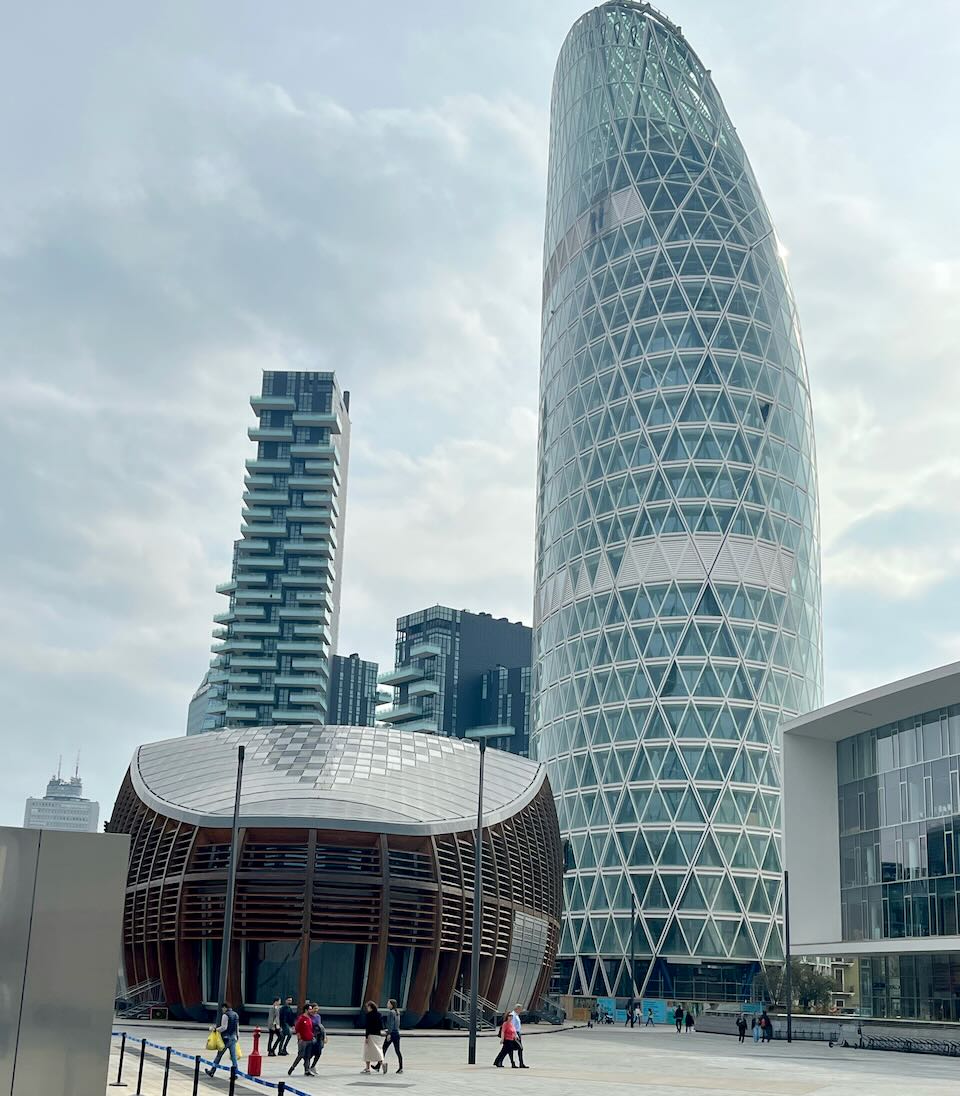
Skyscrapers in Milan’s Porta Nuova district, including the cylindrical glass Unipol Tower.
More Milan Neighborhoods
We’ve covered our favorite neighborhoods to visit and stay in more detail above, but on a longer trip – or subsequent visit – travelers should also consider the following areas:
- San Siro: Soccer fans should consider a visit to this area just west of the city center. The iconic San Siro Stadium is home to both AC Milan and Inter Milan, two of Italy’s – and Europe’s – most successful football (soccer) teams. Watching a game here is an incredible experience, especially on derby day (dubbed the “Derby della Madonnina”). On non-match dayes, you can still visit the on-site museum and tour the stadium. The stadium has its own metro stop, but you can stay the night at Luci a San Siro or good value B&B Hotel Milano San Siro.
- Bicocca: Just over 4 miles north of central Milan (and connected by metro), Bicocca is a modern business and university district with a handful of intriguing sights to explore. The main draw is the Pirelli HangarBicocca, a large contemporary art exhibition space in a converted tire factory (The Seven Heavenly Palaces by Anselm Kiefeis on permanent display). Nearby, shops fill the indoor Bicocca Village mall, concerts take place at Teatro degli Arcimboldi, and the Museo Interattivo del Cinema is must-see for lovers of Italian film. There is a smattering of cheap, very good value hotels up here: AC Hotel Milan Sesto and Grand Hotel Villa Torretta, plus the cheaper Aparthotel Arcimboldi, B&B Hotel Sesto Marelli, Il Girasole, and Hilton Garden Inn Milan North.
- Hotels near Milan Airport: If you have a very early/late flight, you might consider staying at or near the airport. For Milan Malpensa Airport, the Sheraton is the most convenient for Terminal 1, while the Moxy is best for Terminal 2. The Holiday Inn Express is usually a bit cheaper and lies in between the two. For travelers flying in or out through Linate Airport, The Moxy Milan Linate Airport is a good option.
Milan Travel Tips
- Milan Malpensa Airport, 30 miles northwest of the city, is the main international gateway for northern Italy. The Malpensa Express train (€13) zips between the airport and the city center (to Central and Porta Garibaldi stations) in around 1 hour (twice an hour). Taxis are expensive – at least €100 into the city center. Milan’s second airport, Linate, is just 4 miles east of the center. It primarily serves European destinations; you can take the metro into the city, or a city bus (taxis are around €40).
- In Milan, a cosmopolitan city, nearly everyone you encounter will be able to speak or understand English, with the exception of a few taxi drivers and proprietors of small cafes or shops. However, it’s always a good idea to learn some basic Italian words and numbers, as a sign of respect for the local culture. Note that if you venture outside the city for a day trip, you will encounter fewer English speakers, particularly among the older generation in rural Lombardy.
- Several discount cards are on offer for Milan, with the 48-hour Milan Pass and the MilanoCard (24hr, 48hr, 72hr) the most popular of the lot. At €79–89, the Milan Pass is more expensive but offers free entry to over 20 major sights, and public transport. The MilanoCard (from €12.50) includes free public transport and a free audioguide but only discounted access to the same sights. As always, the passes are only good value if you intend to do a lot of sightseeing in a short amount of time. Be realistic about what you can see in 2–3 days.
- Bike rental options in Milan include both bikeshare schemes like bikeMi and traditional rental shops such as AWS. With an abundance of bike lanes and trails, Milan is a great city for cycling, particularly if you choose to stay outside the city center.
- “Open Wifi Milano” provides free wi-fi at around 300 hotspots in Milan.
- Milan’s official tourist information centers can be found at Piazza Duomo 14 and Via dei Mercanti 8. The free maps are useful.
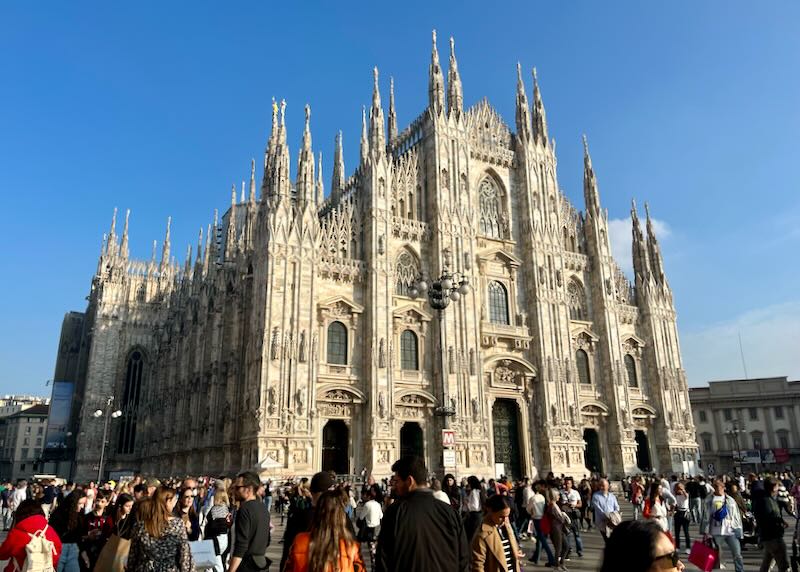
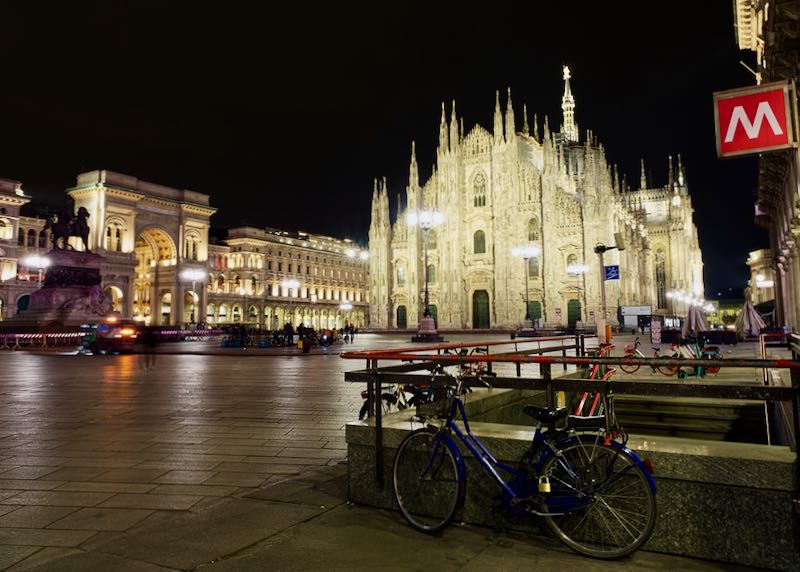
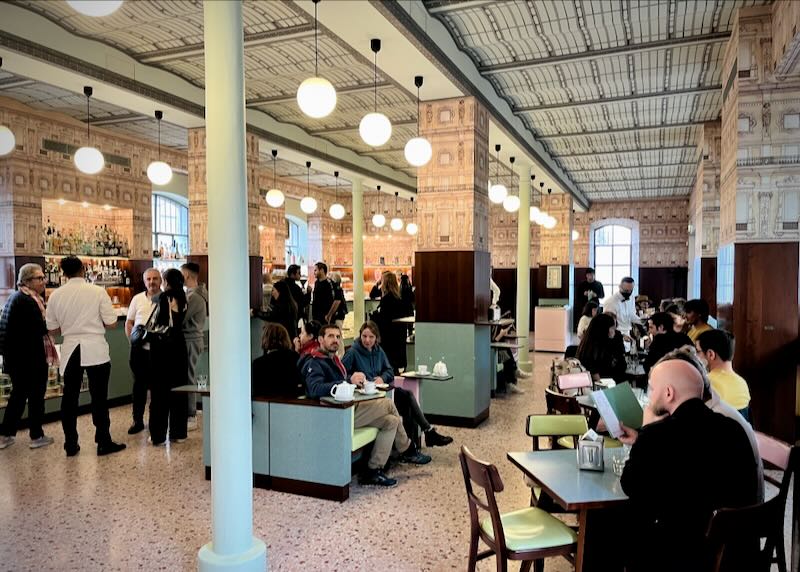
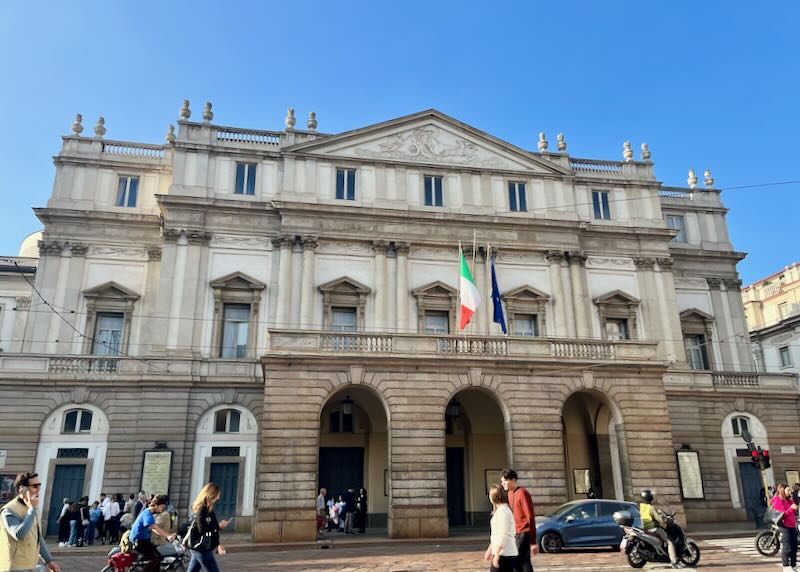

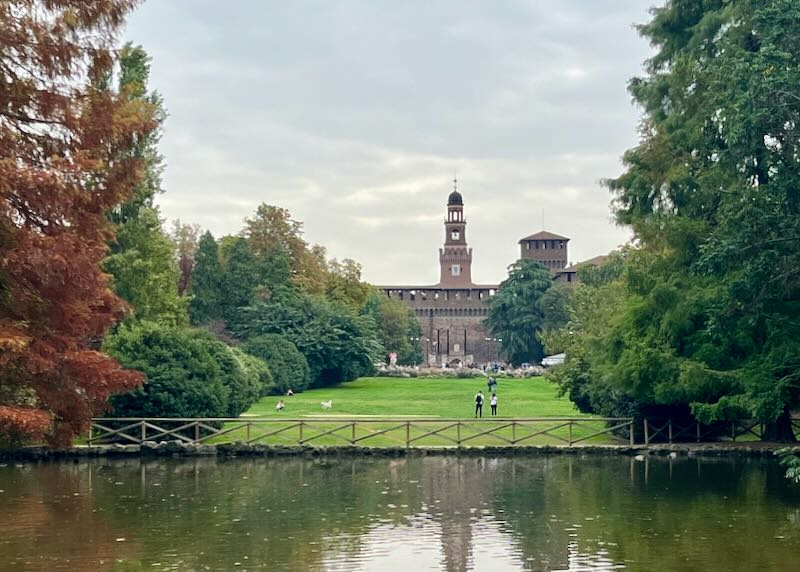

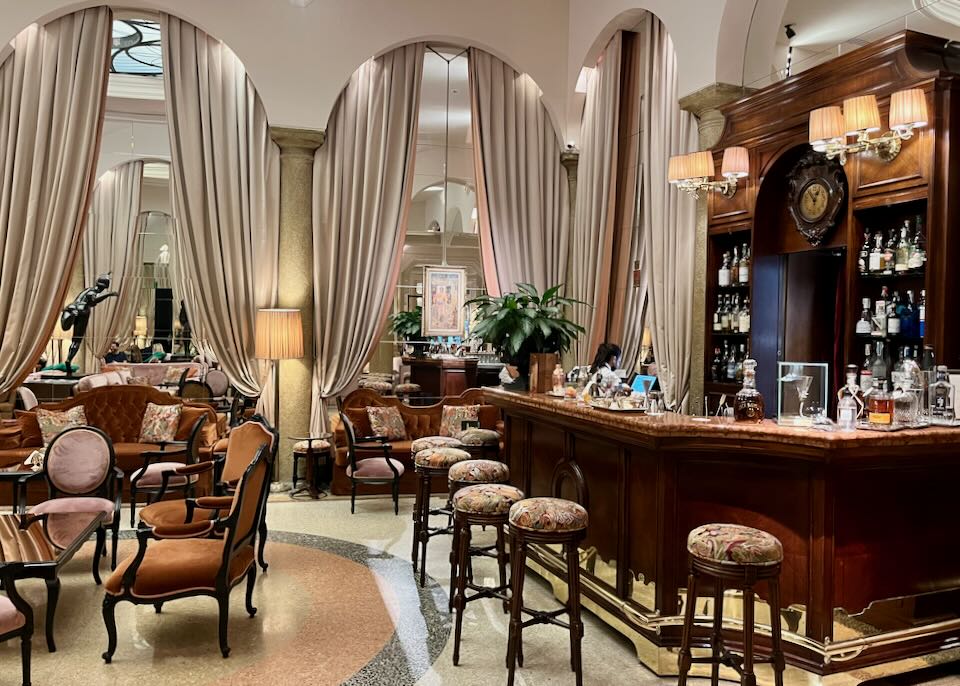
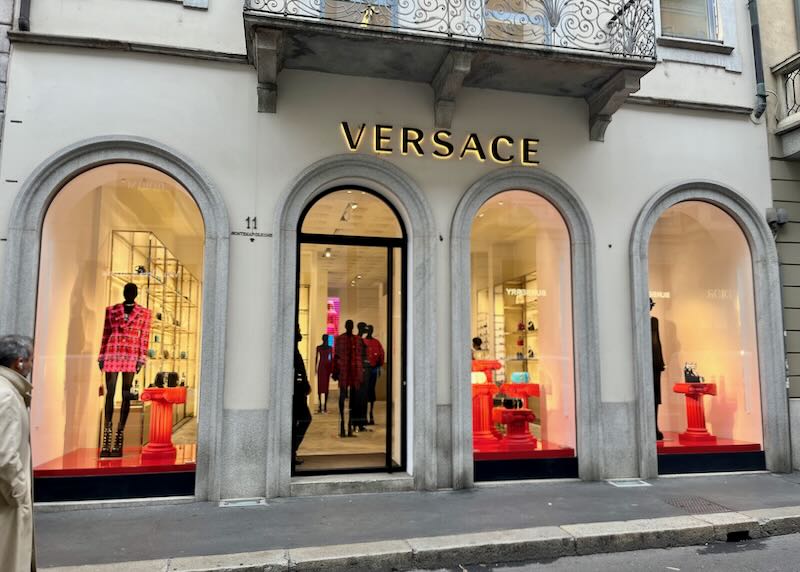

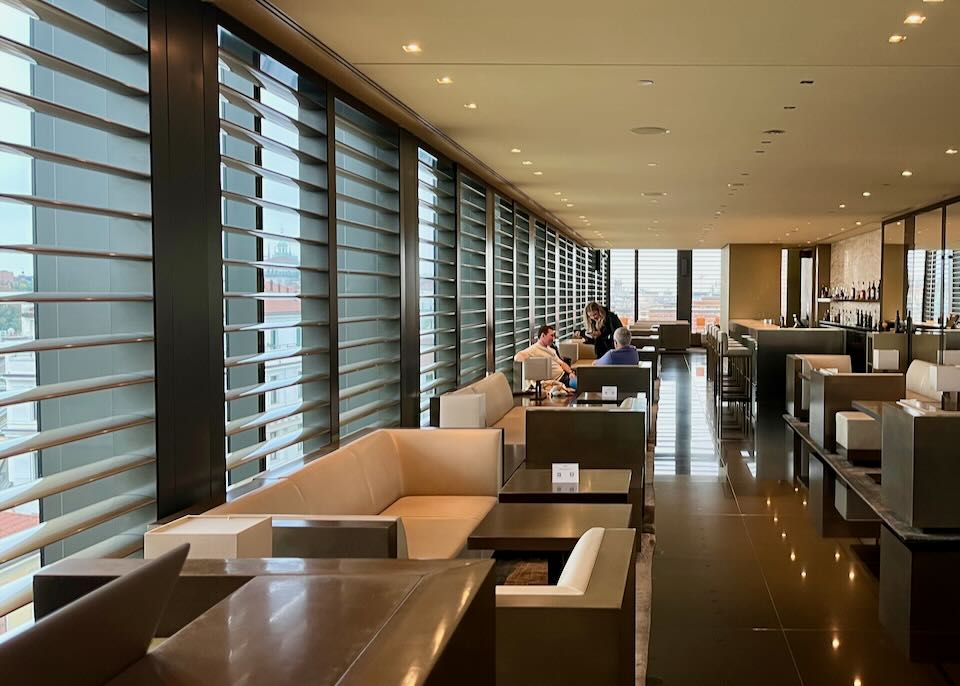
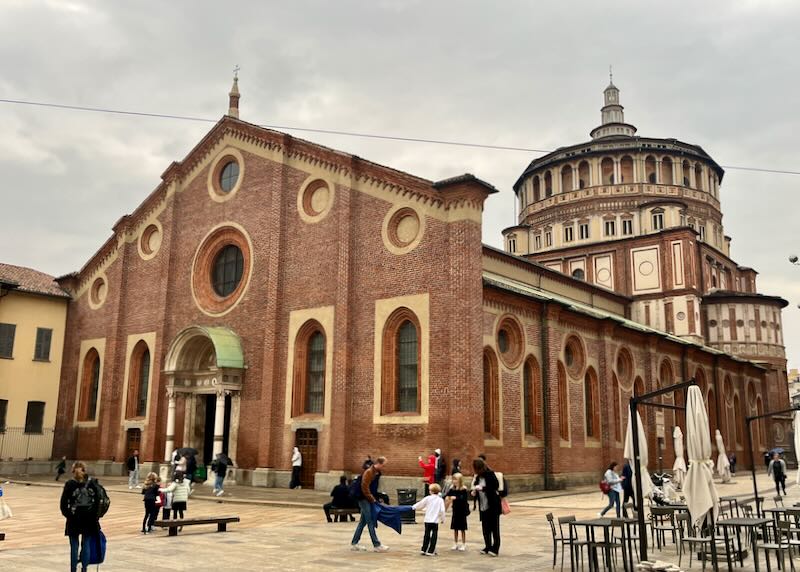

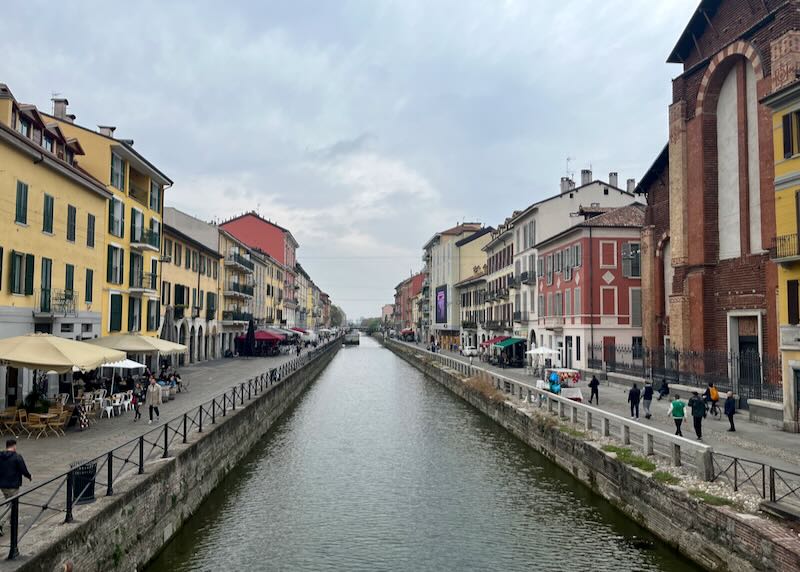

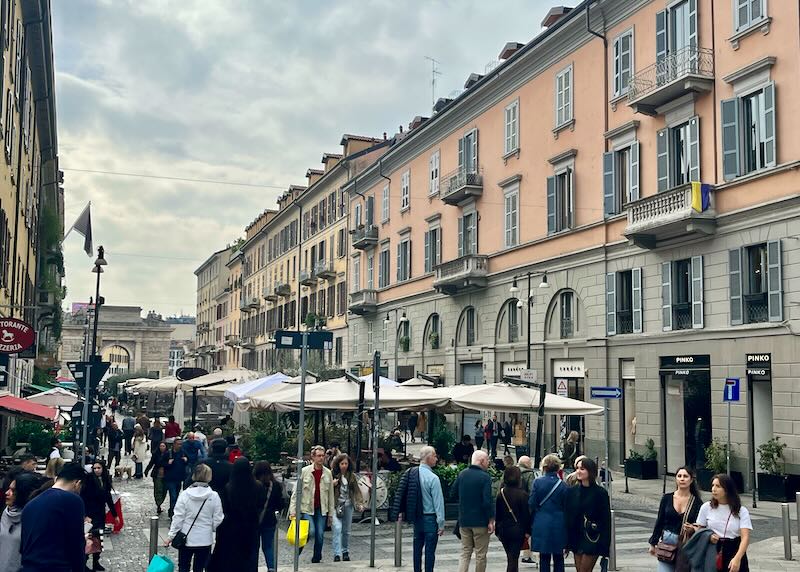

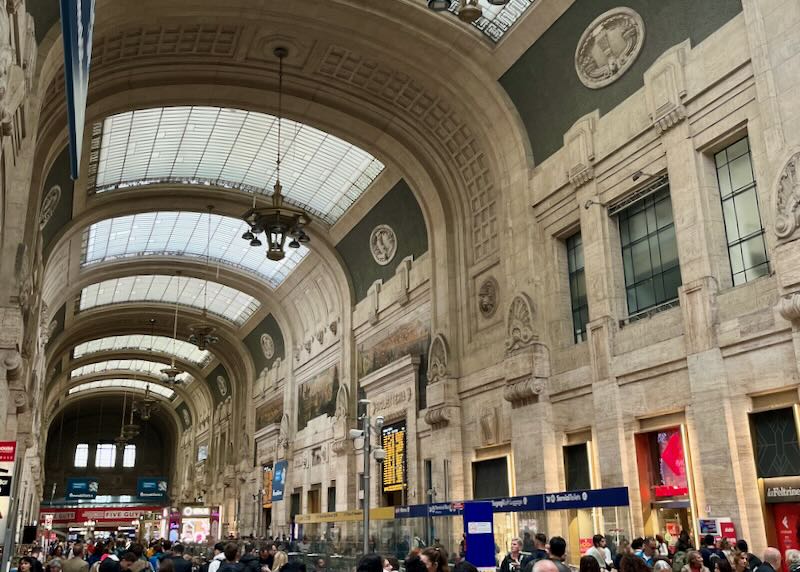

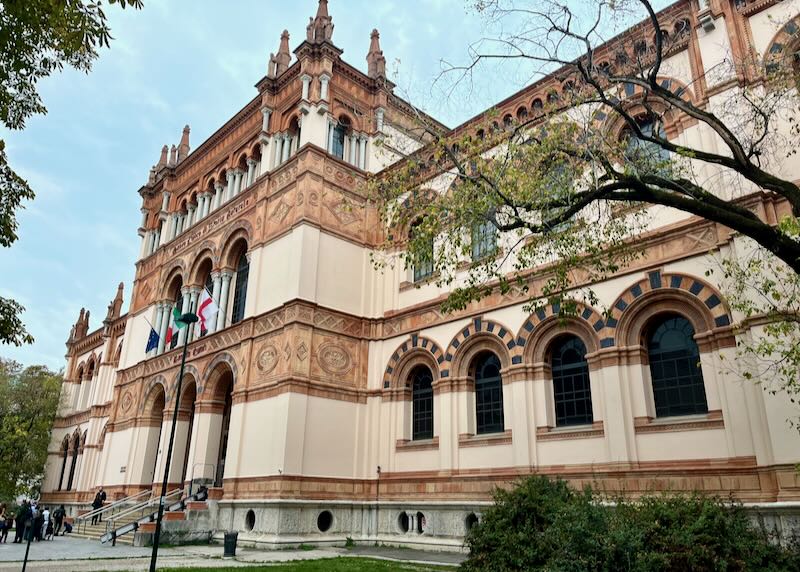

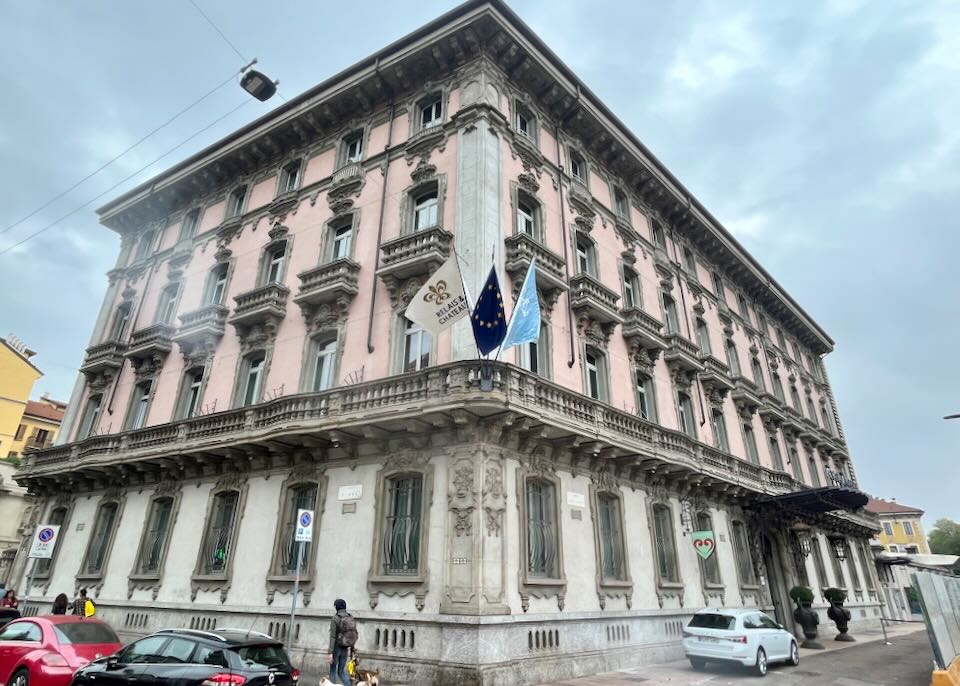
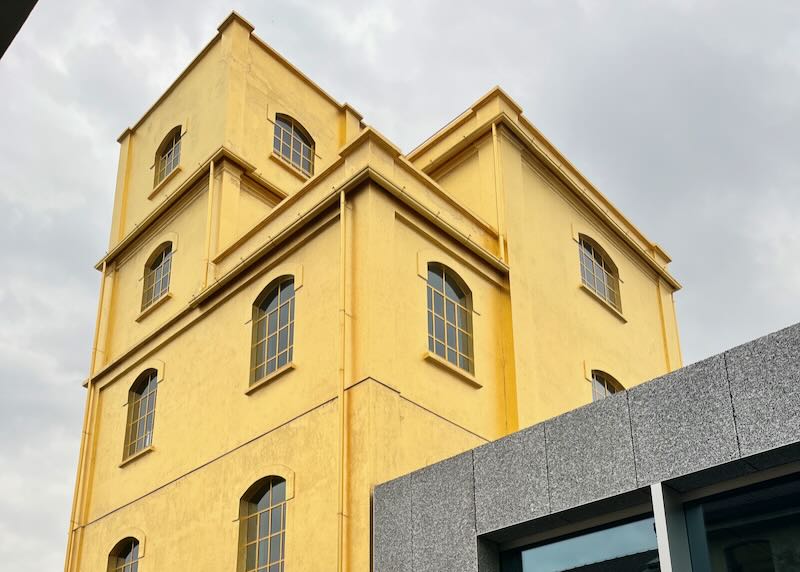

About Santorini Dave